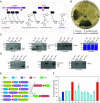Organelle-dependent polyprotein designs enable stoichiometric expression of nitrogen fixation components targeted to mitochondria
- PMID: 37585462
- PMCID: PMC10450427
- DOI: 10.1073/pnas.2305142120
Organelle-dependent polyprotein designs enable stoichiometric expression of nitrogen fixation components targeted to mitochondria
Abstract
Introducing nitrogen fixation (nif ) genes into eukaryotic genomes and targeting Nif components to mitochondria or chloroplasts is a promising strategy for engineering nitrogen-fixing plants. A prerequisite for achieving nitrogen fixation in crops is stable and stoichiometric expression of each component in organelles. Previously, we designed a polyprotein-based nitrogenase system depending on Tobacco Etch Virus protease (TEVp) to release functional Nif components from five polyproteins. Although this system satisfies the demand for specific expression ratios of Nif components in Escherichia coli, we encountered issues with TEVp cleavage of polyproteins targeted to yeast mitochondria. To overcome this obstacle, a version of the Nif polyprotein system was constructed by replacing TEVp cleavage sites with minimal peptide sequences, identified by knowledge-based engineering, that are susceptible to cleavage by the endogenous mitochondrial-processing peptidase. This replacement not only further reduces the number of genes required, but also prevents potential precleavage of polyproteins outside the target organelle. This version of the polyprotein-based nitrogenase system achieved levels of nitrogenase activity in E. coli, comparable to those observed with the TEVp-based polyprotein nitrogenase system. When applied to yeast mitochondria, stable and balanced expression of Nif components was realized. This strategy has potential advantages, not only for transferring nitrogen fixation to eukaryotic cells, but also for the engineering of other metabolic pathways that require mitochondrial compartmentalization.
Keywords: mitochondrial-processing peptidase; nitrogenase; polyprotein; synthetic biology.
Conflict of interest statement
The authors declare no competing interest.
Figures





Similar articles
-
Polyprotein strategy for stoichiometric assembly of nitrogen fixation components for synthetic biology.Proc Natl Acad Sci U S A. 2018 Sep 4;115(36):E8509-E8517. doi: 10.1073/pnas.1804992115. Epub 2018 Jul 30. Proc Natl Acad Sci U S A. 2018. PMID: 30061389 Free PMC article.
-
Plant expression of NifD protein variants resistant to mitochondrial degradation.Proc Natl Acad Sci U S A. 2020 Sep 15;117(37):23165-23173. doi: 10.1073/pnas.2002365117. Epub 2020 Aug 31. Proc Natl Acad Sci U S A. 2020. PMID: 32868448 Free PMC article.
-
Formation of Nitrogenase NifDK Tetramers in the Mitochondria of Saccharomyces cerevisiae.ACS Synth Biol. 2017 Jun 16;6(6):1043-1055. doi: 10.1021/acssynbio.6b00371. Epub 2017 Mar 3. ACS Synth Biol. 2017. PMID: 28221768 Free PMC article.
-
Transfer of Nitrogen Fixation (nif) Genes to Non-diazotrophic Hosts.Chembiochem. 2020 Jun 15;21(12):1717-1722. doi: 10.1002/cbic.201900784. Epub 2020 Mar 2. Chembiochem. 2020. PMID: 32009294 Review.
-
Challenges to develop nitrogen-fixing cereals by direct nif-gene transfer.Plant Sci. 2014 Aug;225:130-7. doi: 10.1016/j.plantsci.2014.06.003. Epub 2014 Jun 11. Plant Sci. 2014. PMID: 25017168 Review.
Cited by
-
Increased dependence on nitrogen-fixation of a native legume in competition with an invasive plant.Plant Divers. 2024 Apr 11;46(4):510-518. doi: 10.1016/j.pld.2024.04.003. eCollection 2024 Jul. Plant Divers. 2024. PMID: 39280977 Free PMC article.
References
-
- Erisman J. W., Sutton M. A., Galloway J., Klimont Z., Winiwarter W., How a century of ammonia synthesis changed the world. Nat. Geosci. 1, 636–639 (2008).
-
- Sutton M. A., Bleeker A., Environmental science: The shape of nitrogen to come. Nature 494, 435–437 (2013). - PubMed
-
- Dixon R., Kahn D., Genetic regulation of biological nitrogen fixation. Nat. Rev. Microbiol. 2, 621–631 (2004). - PubMed
Publication types
MeSH terms
Substances
Grants and funding
LinkOut - more resources
Full Text Sources
Molecular Biology Databases

